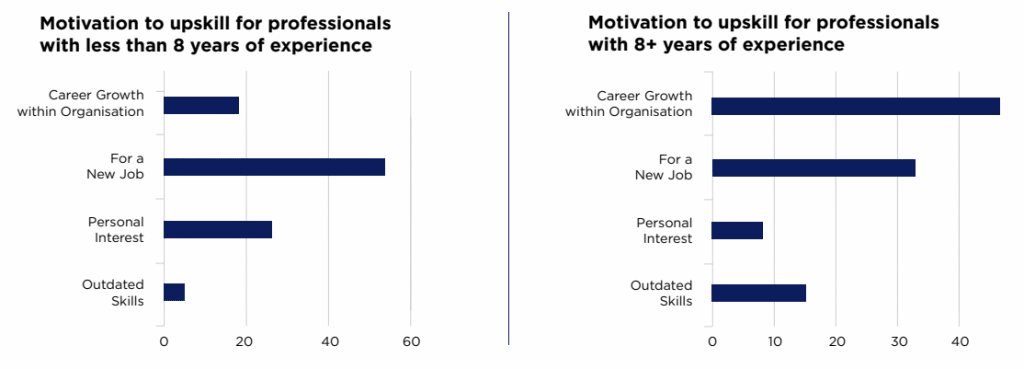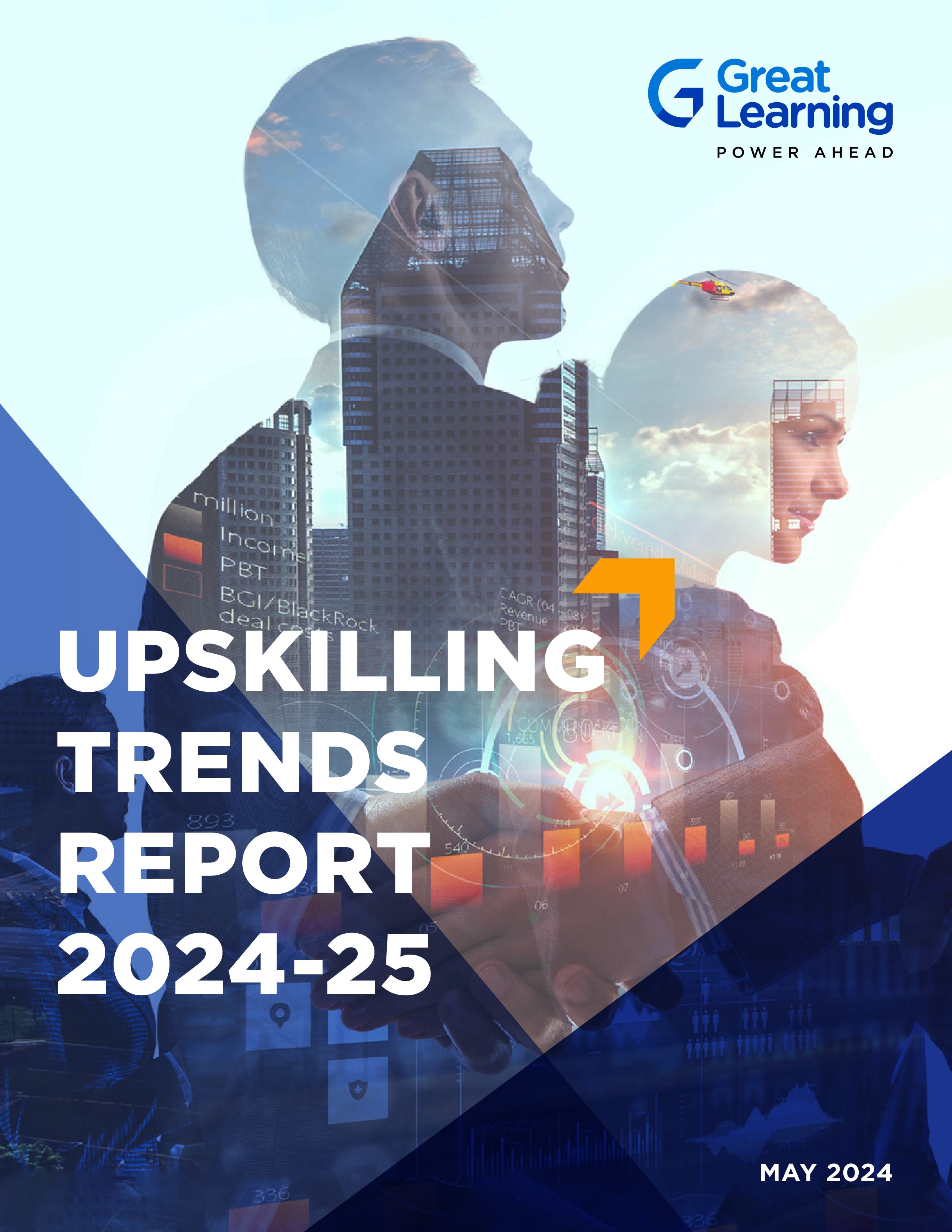- I. DOMAIN PREFERENCE
- II. TOP CITIES FOR UPSKILLING AND CITIES WITH THE HIGHEST GROWTH VS 2021
- III. GENDER AND WORK EXPERIENCE AMONG THOSE WHO UPSKILLED IN 2022
- IV. SECTOR-WISE BREAK-UP
- V. TIME AND DURATION OF LEARNING
- VI. MOTIVATION TO UPSKILL
- VII. CAREER OUTCOMES
- UPSKILLING TREND IN - 2023
- I. CONFIDENCE OF KEEPING JOB
- II. IMPORTANCE OF UPSKILLING
- III. INTENT TO UPSKILL
- IV. MOTIVATION FACTORS
- V. HURDLES IN UPSKILLING
- VI. BACK TO OFFICE
- ENTERPRISE TRENDS
Upskilling continues to be a constant focus as job roles evolve, and we expect it to be even more important in 2024. The global educational services market saw immense growth last year thanks to easily accessible online education, a plethora of programs and certifications, and flexible learning pathways. In addition, the increased adoption of technology across industries also spurred the demand for programs in Data Science, Tech, Management, and other related disciplines. IT, Banking, Manufacturing, Education/Training, and Healthcare & Pharma were the top five sectors for upskilling in 2024.
In 2023, when the job markets are already looking brutal, professionals worldwide will continue investing in skill development programs to retain their jobs and accelerate their career progression, specifically in the Management, Digital Marketing, Data Science and Analytics, and Software Development domains. This augurs well for organizations that are currently facing a shortage of high-quality talent in these areas.
The Upskilling Trends Report 2023 is a valuable resource for professionals and students who wish to learn new skills and advance their careers by providing insights into market trends and skill gaps. The report also aims to assist business unit heads and L&D professionals in understanding how other organizations are upskilling their employees, identifying key motivators for upskilling, and developing a strategic approach to future-proof their businesses based on the latest trends and their effects across various industries and geographies.
By providing a thorough analysis of upskilling developments in 2022 and making predictions for the upcoming year, the Upskilling Trends Report 2023 is designed to help individuals and businesses navigate the job market, anticipate future skills requirements, and remain competitive by staying informed and up-to-date on industry trends and best practices.
The report is based on profiling learners across India who enrolled in Great Learning’s programs last year. In addition, it incorporates survey responses from the same cluster of learners to understand their motivations to upskill and career outcomes. For the 2023 Upskilling Outlook section, Great Learning collaborated with a third-party research agency to survey a sample of working professionals from all the major sectors.
I. DOMAIN PREFERENCE
Data literacy has become the current language of business so it’s no surprise that the most in-demand domain for upskilling was Data Science in 2022. With automation set to displace 85 million jobs globally by 2025, many Indian professionals are choosing to learn new digital technologies in order to cash in on this economic transformation. The prospect of an increased salary, higher career growth, and acquiring additional technical expertise has pushed professionals towards upskilling in new-age domains

- Data Science was the top skill acquired by learners in 2022, followed by Software Engineering and Management.
- Artificial Intelligence and Cloud Computing programs were popular among professionals with 8+ years of work experience.
- Data Science, Software Engineering and Management programs were pursued mostly by freshers and entry-level professionals.
- Cybersecurity was pursued by professionals across all work experience levels.
II. TOP CITIES FOR UPSKILLING AND CITIES WITH THE HIGHEST GROWTH VS 2021
METROS
In 2022, among metro cities, Bengaluru – the technology capital of India, saw the maximum demand for upskilling programs followed by Chennai, Hyderabad, Mumbai, Pune, and Delhi. Among tier 2 cities, Mysore, Madurai, Indore, and Vijayawada saw the maximum intent for upskilling.
TIER 2 CITIES
Professionals from tier 2 cities are choosing to upskill in order to have more career opportunities and boost their earning potential, thereby increasing the demand for upskilling. As South India has a higher concentration of IT industries and businesses, the demand for upskilling is highest there. Among the fastest-growing cities, the highest growth for upskilling programs in 2022 vs 2021 was seen in cities like Vadodara, Coimbatore, Tiruchirapalli, Salem, Patna, Jaipur, and Kochi
III. GENDER AND WORK EXPERIENCE AMONG THOSE WHO UPSKILLED IN 2022

In general, more male professionals enrolled in upskilling programs in 2022, but the gap in representation becomes more pronounced at higher levels of work experience. This is even lower than the general industry trend for female representation at mid to senior positions.
Upskilling at senior levels requires a significant time and effort commitment, and senior women professionals may lack the confidence to take on such a commitment, in addition to their other responsibilities.
IV. SECTOR-WISE BREAK-UP
| Sectors | 2022 Rank | Sectors | 2021 Rank |
| IT/ITES | 1 | IT/ITES | 1 |
| BFSI | 2 | Manufacturing | 2 |
| Manufacturing | 3 | BFSI | 3 |
| Education and Training | 4 | Healthcare and Pharma | 4 |
| Healthcare and Pharma | 5 | Consulting | 5 |
In 2022, IT/ITES and BFSI were the top sectors where professionals upskilled, followed by Manufacturing, Educational Services, and Pharma.
Last year’s Upskilling Outlook Report predicted that IT, Banking, Manufacturing, Education/Training and Healthcare & Pharma would be among the top 5 sectors and this year’s data seems to validate the same.
V. TIME AND DURATION OF LEARNING

VI. MOTIVATION TO UPSKILL
With the rapidly changing business landscape and unfavorable macroeconomic conditions, it has become increasingly important for professionals to acquire new skills and knowledge to remain relevant. Gaining new-age skills and thus securing and growing in one’s career either with a new job or by doing better in one’s existing role are the most powerful motivators for professionals to upskill. Job


The major motivation for professionals with 0-8 years of work experience was to secure a new job, while those with 8+ years of experience aimed to achieve career growth within their current organization.
VII. CAREER OUTCOMES
Upskilling today has become a necessity for working professionals looking to advance their careers, and the ROI of these efforts is a key consideration. It’s not just about gaining new skills for the sake of learning, as these upskilling efforts need to have a clear career outcome. Professionals are increasingly able to transition into new domains with the help of upskilling.

Upskilling helped 43% of professionals gain career growth in their own organization, while 23% were able to switch to a different domain and 18% were able to secure a new job.
Upskilling in areas such as Management and Software Development provided the most benefits to learners in their own organization. However, upskilling in Data Science helped professionals transition to a new career domain.
UPSKILLING TREND IN – 2023
I. CONFIDENCE OF KEEPING JOB
Despite the dire macroeconomic conditions, a large percentage of people are optimistic about keeping their jobs as they have been proactive in building a career cushion by upskilling and keeping their options open. By developing new skills and knowledge, they are better equipped to adapt to changes in the job market and maintain their employability. This optimistic outlook of many people in this situation is a testament to the power of upskilling and how it prepares professionals for the ever-changing nature of jobs.

71% of professionals in India are confident about keeping their jobs

BASED ON CITIES
Cities like Mumbai and Delhi whose economy is driven by ‘traditional’ sectors like Manufacturing, Telecom, Financial Services, etc., have employees feeling more confident about their job outlook, with professionals in Mumbai feeling the most confident compared to other cities. On the other hand, cities with an IT-driven economies like Bangalore and Hyderabad faced significant disruptions due to macroeconomic factors, which have led to decreased confidence levels among professionals.
BASED ON WORK EXPERIENCE
Only 63% of professionals with 0-3 years of experience and 83% of professionals with 6+ years of experience are confident about retaining their jobs.
II. IMPORTANCE OF UPSKILLING
The importance of upskilling and ongoing L&D has never been greater. The nature of jobs and skills required is drastically different from before. Modern-day recruiters are looking for professionals who are equipped with new-age skills, making it crucial for employees to invest in upskilling in order to future-proof their careers.
85% of Indians believe that upskilling is necessary to future-proof their career.

Professionals from Mumbai, Lucknow, Hyderabad, and Bangalore place the highest importance on upskilling, followed by Delhi, Coimbatore, and Pune.
BASED ON WORK EXPERIENCE
85% of professionals with less than 3 years of experience consider upskilling to be important for their career prospects. Despite having job security, 93% of professionals with 9+ years of experience consider upskilling to be important for their careers.
BASED ON SECTOR
92% of professionals in the IT and Manufacturing sectors believe that upskilling is important for securing their future careers, followed by 89% of professionals from the Education and Training sector, and 84% from the BFSI sector.
III. INTENT TO UPSKILL
The 21st century demands professionals stay in sync with the latest industry trends and technologies. With a growing number of people recognizing the value of upskilling, many have taken active plans to invest in their own education and are taking concrete steps to do so. This trend reflects a shift in the way people view their careers, as they are becoming more proactive in shaping their own paths and taking control of their futures.

- The desire to upskill among Indians has increased by 4 points from the previous year. In 2022, 79% of professionals were planning to upskill. In 2023, that number has risen to 83%.
- The intent to upskill is higher among men as compared to women. In 2023, 83% of male and 80% of female professionals plan to upskill.
The highest proportion of the workforce who plan to upskill in 2023 are from IT/Tech and BFSI sectors, followed by Education/Training, Manufacturing, and Automobile industries.

Indians are primarily looking to upskill in the Software Development, Data Science and Analytics, Digital Marketing, Management, and Artificial Intelligence domains.
Most professionals from Bangalore, Delhi, Hyderabad, Mumbai, and Lucknow are seeking to upskill in Software Development, while professionals in Chennai, Coimbatore, and Kolkata are looking to upskill in Data Science and Analytics.
Professionals with less than 3 years of experience are primarily looking to acquire Software Development skills, while professionals with 9+ years of experience are focused on learning Management and leadership skills.
IV. MOTIVATION FACTORS
The most important factor for Indians who plan to upskill in 2023
In 2023, the primary motivation for Indians to upskill is career growth within their current organization. This is followed by personal interest and the expectation of new job opportunities as a result of upgraded skills.
V. HURDLES IN UPSKILLING

The biggest obstacle for female professionals in India to pursue upskilling programs is balancing household chores and family responsibilities, while for men, it is typically workplace demands.
VI. BACK TO OFFICE
As offices have begun to reopen and employees are returning to work after “working from home” for almost 2 years, the focus has shifted towards collaboration, teamwork, and brainstorming. This shift towards in-person interactions has resulted in less time for employees to focus on upskilling, as they now need to adjust to working in a team-oriented environment again.

In the 2022 Outlook Report for India, 62% of respondents stated that returning to the office would not affect their plans to upskill. However, in the 2023 Outlook Report, 67% of respondents indicated that going back to the office would impact their decision to invest in upskilling.
ENTERPRISE TRENDS
Building Future-Proof Organisations
Across the globe, technology-driven disruption is currently posing a challenge for organizations at an unprecedented scale. On the one hand, it creates the risk that current skills may not align with future job requirements and could quickly become obsolete.
However on the other hand, it also presents enterprises with significant opportunities for innovation and growth in a competitive landscape.
Businesses need to be adaptive and readily respond to opportunities and challenges. Market leaders across industries have realised that upskilling and reskilling are crucial to building an agile and future-ready workforce. Our conversations with enterprise partners and some of the prominent L&D and HR leaders offered profound insights, which are presented below.
I. AN APPETITE FOR SKILLED TALENT
Now more than ever, it is critical for enterprises across industries to possess a talent-first mindset that enables them to shape a skilled, future-ready workforce that helps deliver their business goals. Here are the sectors that recorded significant investments in upskilling and reskilling programs in 2022.
- IT/ITES
- BFSI
- Tech Consulting
- Manufacturing
- E-commerce
II. IN-DEMAND TECH & DATA SKILLS
Enterprises are increasingly investing in effectively mitigating skill shortages to stay competitive in the market. What skills do these companies consider crucial to achieving their business outcomes, and what talent gaps are they seeking to fill? Here’s a list of the top skills which employers invested in last year:
- Full Stack Development
- Data Science & Data Engineering
- Cybersecurity
- Cloud Computing
III. SUPPORT FROM EMPLOYERS FOR UPSKILLING/RESKILLING
Enterprises are more inclined towards customized training, with 30% of employers in various regions opting for it, as it aligns more with their business outcomes. Another 25% of employers provide subscriptions to self-paced content. While 12% provide monetary support in the form of reimbursements, 20% of employers do not offer any kind of upskilling support.
IV. LEARNING & DEVELOPMENT FOR ALL
Today, employee training is an indispensable engine for business growth, prompting organizations to encourage their employees, from freshers to C-suite leaders, to acquire new skills. Notably, a considerable portion of the investment is allocated towards fresher training for additional skill development, and initiatives for mid and senior-level executives emphasize technical training and data-driven decision-making to stay in line with market trends.
V. DELIVERY MODES FOR CUSTOM TRAINING PROGRAMS
To make the most productive use of their employees’ time, employers offer a variety of synchronous, asynchronous, and hybrid learning formats to acquire new skills or knowledge. Customized learning solutions are typically delivered in a blended format, which involves a combination of video-based learning and mentoring from a faculty or industry expert, or virtual instructor-led training (VILT), which is preferred by many enterprises.
VI. HITTING THE GROUND RUNNING
A key objective of fresher training programs is to ensure the earliest possible deployment of their skills within the organization, with many organizations opting for a hybrid training model that includes both pre- and post-onboarding training.
VII. YARDSTICK OF SUCCESS
The success of a skill development program is no longer measured by only the number of hours the employee spends getting trained. Employers are now more attentive to other factors that contribute to the ROI.
- Reduction in time to make freshers billable.
- Increase in skill capability based on certified employees.
- Greater internal mobility and improved retention.
- Decrease in employees’ time spent on the bench.


